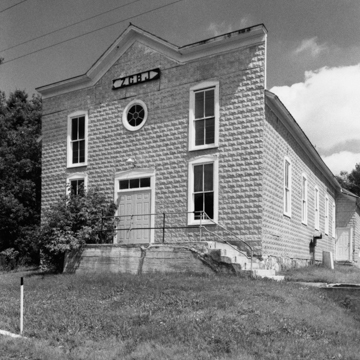Czechs were the first Slavs to come to Wisconsin in large numbers, and Wisconsin was the first center of rural Czech settlement in the United States. Many farmers and tradesmen—especially Freethinkers and socialists who rejected Austrian rule and the authority of the Catholic clergy—left Bohemia and Moravia after 1848, a year of revolutionary changes in much of Europe. These Czech immigrants founded numerous farm villages in the 1850s in the eastern and southwestern parts of the state. The 1890s saw some Czech Americans leaving established communities for the newly cutover land of northern Wisconsin. A hundred or so Czech families bought land in this flat area north of Cadott. The sellers, the Cypreanson brothers of Eau Claire, had advertised in Czech-language newspapers in southwestern Wisconsin. They also donated a plot for a Bohemian cemetery and gave money to help build a meeting hall. This last gesture appealed to Czech Americans who had rejected the church, and secular meeting halls thus accommodated weddings, funerals, social gatherings, dances, language classes, and other means of preserving Czech culture.
This example built in 1907 with volunteer labor is a frame structure whose false front, common for Czech halls, partially hides a front-facing gable. Classical details include door and window moldings, a three-light transom over the entrance, and a circular, stained glass window lighting a balcony inside. Metal siding stamped with a rusticated stone pattern clads the exterior walls. Rarely preserved in such good condition, embossed-metal veneering was popular for turn-of-the-twentieth-century community and commercial buildings, particularly in rural areas. The idea was to mimic stone while pinching pennies. Inside, the maple-floored meeting hall has a balcony at the west end and a semicircular wooden stage at the east, where the actors presented Czech plays. A simple proscenium molding frames two roll-down curtains, the rear one depicting Karlštejn Castle near Prague, as painted by itinerant artist Emil Piler in 1931. A reversible stage backdrop, painted in 1915, features a Czech street scene on one side and a rural woodland setting on the other. The 1930 addition to the rear contains backstage facilities, a kitchen, and a basement tavern.
This hall housed a chapter of the Západní Česko Bratrská Jednota (Western Bohemian Fraternal Association), an organization that offered its members insurance and other financial services and sponsored social and cultural activities. The building also provided space for the local Sokol, a gymnastic organization that began in Prague in 1862 and quickly spread to Czech immigrant communities throughout America. Much like the German Turnvereins, the Sokol linked physical fitness to ideals of liberalism and nationalism.


